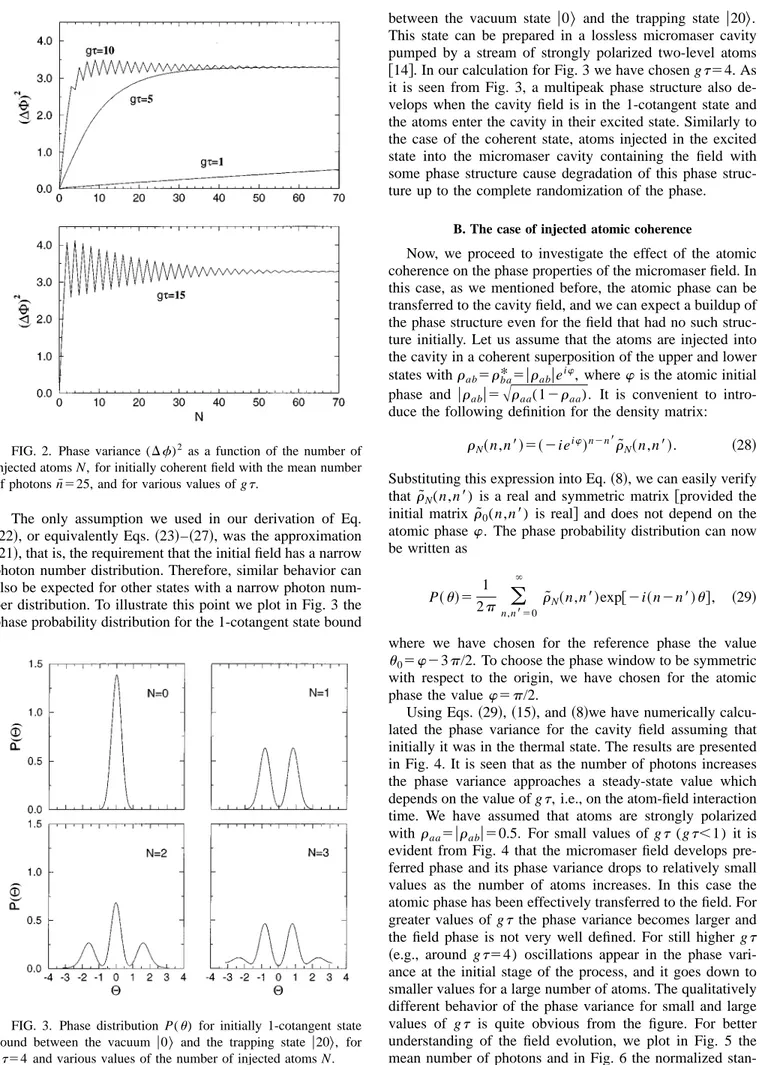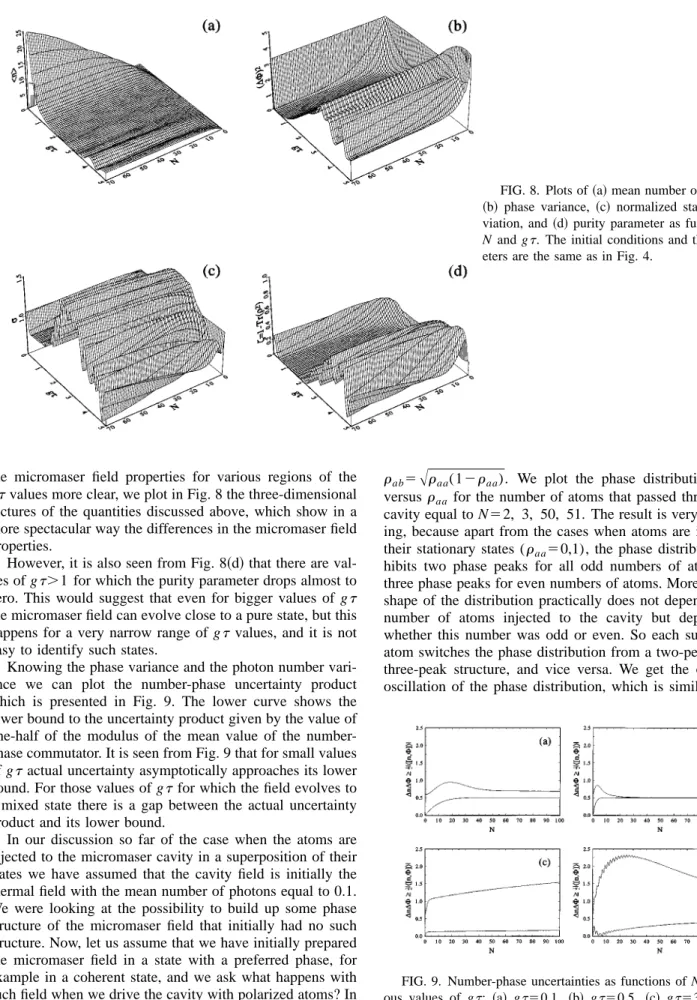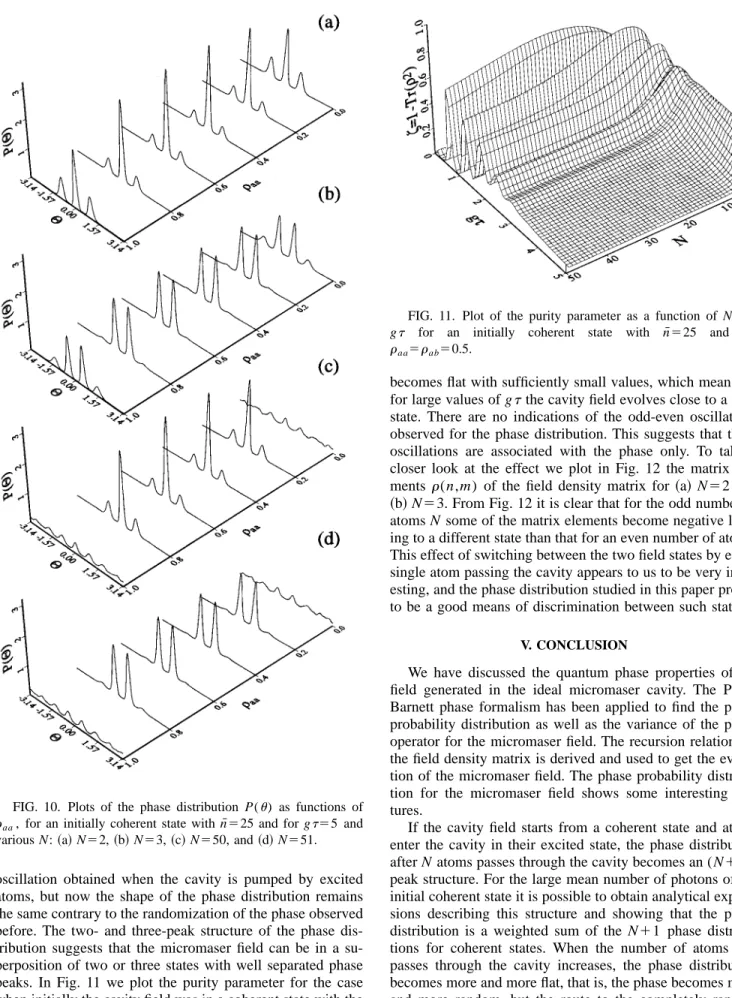Quantum phase properties of the field in a lossless micromaser cavity
Tseresodnom Gantsog*Max-Planck-Institut fu¨r Quantenoptik, Hans-Kopfermann-Strasse 1, D–85748 Garching, Germany Ryszard Tanas´
Nonlinear Optics Division, Institute of Physics, Adam Mickiewicz University, 60-780 Poznan´, Poland ~Received 16 May 1995!
Phase properties of the micromaser field are studied for different initial states of the cavity field and the atom. It is shown that a multipeak phase structure develops when the cavity field is initially in a coherent state and the atoms enter the cavity in their excited state, which eventually leads to the randomization of the phase. If initially the field is thermal and the atoms entering the cavity are polarized, the steady state with a consid-erably well defined phase is reached, which asymptotically can be one of the cotangent states or some mixed state depending on the atom-cavity interaction time. An interesting effect of switching between the two- and three-peak phase structure caused by each subsequent atom passing the cavity has been found.
PACS number~s!: 42.50.Dv, 42.52.1x
I. INTRODUCTION
One of the marvelous experimental and theoretical sys-tems for the study of truly quantum aspects of the interaction between radiation and matter is the one-atom maser, or mi-cromaser @1–16#. A micromaser consists of a microwave cavity and a stream of excited atoms which drive the field inside the cavity. The beam is sufficiently sparse so that at most one atom at a time is present inside the cavity. The photon statistics of a micromaser shows interesting quantum effects including sub-Poissonian photon statistics@1,3,4# and collapse and revival of Rabi oscillations@5#. Even a number state can be generated using a cavity with a high enough quality factor and with no thermal photons @6#. Both condi-tions can be fulfilled when the superconducting cavity is op-erated at very low temperatures. In this case even more in-teresting features may show up, such as trapping states of the cavity@3,7#. Moreover, the micromaser allows us to prepare and measure the off-diagonal elements of the field density matrix @8#. The spectrum @9# and the phase diffusion coeffi-cient @10–12# of the micromaser field, which involve the off-diagonal elements of the field density matrix, have been calculated, and a method of inferring them from the proper-ties of the emerging atomic beam has been proposed. The possibility of generating a coherent state of the micromaser field has also been predicted@13#. One of the very intriguing features of the micromaser is the possibility of obtaining pure states of the field, so-called tangent and cotangent states @14#, if the initial conditions are properly chosen. Phase properties and squeezing of the cotangent states have been studied by Meystre et al.@15#.
In this paper, we consider the problem of quantum phase fluctuations of the field generated in the lossless micromaser cavity. In our discussion we use the Pegg-Barnett Hermitian phase formalism@17#. The phase probability distribution for
different initial atomic and field states is calculated and its evolution illustrated graphically. We have found that the phase distribution function exhibits a number of interesting features. In particular, if the micromaser starts from the co-herent field and is pumped by excited atoms the phase dis-tribution function develops N11 separate peaks as N atoms have passed through the cavity, suggesting the appearance of the superposition states. In fact, the sequence of more and more peaks that appear in the phase distribution for an in-creasing number of injected atoms leads to the randomiza-tion of the phase, i.e., to making the phase distriburandomiza-tion more and more uniform.
On the other hand, if the maser cavity starts with thermal field and is driven by polarized atoms, the field in the cavity that initially had no preferred phase acquires some phase from the atoms, and a phase peak develops during the evo-lution. We show that the phase properties of the cavity field evolve to a steady state as the number of injected atoms increases, but character of this state depends strongly on the atomic interaction time. The existence of the trapping states has an impact on the phase properties of the micromaser field and, despite the fact that thermal field is defined on the whole Fock space, there are intervals of interaction times for which field asymptotically evolves to a pure state, which is an appropriate cotangent state, but there are also intervals of interaction time for which the resulting state is a mixed state. An interesting effect appears when the cavity field is ini-tially in a coherent state and the cavity is pumped by the polarized atoms. In this case two different phase structures, one with two phase peaks and another one with three peaks, develop. Each subsequent atom traversing the cavity switches the cavity field between the two structures. If the number of atoms that passes the cavity is odd, the two phase peaks are observed, and for an even number of atoms three peaks appear. The shape of the two phase distributions does not depend on the number of atoms that passes the cavity but on the parity of this number.
The paper is organized as follows. In Sec. II, we derive the exact recursion relation for the field reduced density ma-*Permanent address: Department of Theoretical Physics, National
University of Mongolia, 210646 Ulaanbaatar, Mongolia.
53
trix. In Sec. III, we shortly review the Pegg-Barnett phase formalism which we use in the further parts of the paper. In Sec. IV, we study the phase properties of the micromaser field for different initial atomic and field states. Finally, Sec. V contains a conclusion.
II. QUANTUM EVOLUTION OF THE FIELD STATE The Hamiltonian describing the interaction of a single two-level atom with a quantized cavity field is given, in the dipole and rotating-wave approximations and in the interac-tion picture, by@5#
H5\g~aua
&^
bu1a†ub&^
au!. ~1! Here the operator ui&^
ju (iÞ j) describes the transition from level j to level i, a and a† are the photon annihilation and creation operators of the cavity mode, and g is the atom-cavity mode coupling constant, which we assume to be real. The transition between the atomic upper level a and the lower level b is assumed to be resonant with the cavity mode. This simplified model is usually referred to as the Jaynes-Cummings model.The dynamics associated with the Jaynes-Cummings model are exactly soluble @5#. By using the relation ui
&^
juuk&^
lu5ui&^
ludk jwe can easily show that~H/\!2k5g2k@~aa†!kua
&^
au1~a†a!kub&^
bu#,~2! ~H/\!2k115g2k11@~aa†!kaua
&^
bu1~a†a!ka†ub&^
au#,where k (k>0) is an integer number. Hence, the time-evolution operator U(t) of the atom-field system can be ex-pressed in the form@5,18#
U~t


